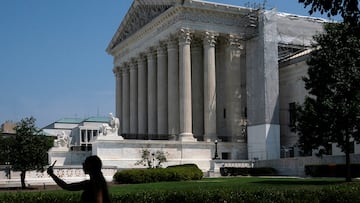Supreme Court declines to lift block on student loan debt relief plan: When can Biden’s SAVE plan be implemented?
The implementation of President Biden’s SAVE program to provide some relief to student debt holders is on pause after facing opposition from the courts.

The Supreme Court has declined a request by the Biden administration to lift a stay on the implementation of its SAVE student loan repayment plan. The Education Department set up the new the Income-Driven Repayment (IDR) plan after President Joe Biden’s sweeping plan to forgive student debt was struck down by the high court last year.
The new debt relief plan would slash monthly payments and reduce the amount of time borrowers must make repayments before they are eligible for debt forgiveness. The Department of Education put borrowers who have already signed up for the plan in an interest-free forbearance in response to its implementation being blocked by the courts.
The Supreme Court did not provide any explanation for its decision and there were no noted dissents. However, the brief order noted that it “expects that the Court of Appeals will render its decision with appropriate dispatch.” CNN noted that this signals that the Justices want the case to play out in the lower courts before they take it up on their emergency appeals docket.
Implementation has been paused by the courts
The program was set to go into effect in July but has been held up in the courts. On July 18, a court stayed a motion to prevent the implementation after a legal challenge was brought by GOP-led states.
The department released a statement providing an update on the case shortly after informing those who had enrolled that they were entering a period of forbearance. “Borrowers enrolled in the SAVE plan are being moved into forbearance. During forbearance, SAVE borrowers will not have to make payments,” reported the Department. Borrowers should be aware, however, that “time in forbearance will not count toward Public Service Loan Forgiveness or Income-Driven Repayment (IDR) loan forgiveness.”
***STUDENT LOAN ALERT***@usedgov is currently unable to operate the Saving on a Valuable Education (SAVE) for student loans, due to a federal court order issued on July 18, 2024. Updated information is available at https://t.co/Eb9V3Xt5oU. pic.twitter.com/m0U26WjHx2
— IDFPR (@IDFPR) July 24, 2024
In late July, the Department announced that it would send personalized messages to borrowers detailing the student debt relief programs that they may be able to enroll in.
Breaking: Beginning August 1, ED will begin emailing all federal student loan borrowers to provide updates on potential student debt relief; borrowers have until August 30 to opt out if they do not want this relief. https://t.co/1E6XE3JLKJ pic.twitter.com/XmPijwLKFH
— U.S. Department of Education (@usedgov) July 31, 2024
How much will the plan reduce payments by?
The SAVE plan will reduce monthly payments for borrowers who meet certain income requirements to zero. The proposed regulations would increase the amount of income protected from repayment from 150 percent of the Federal poverty guidelines to 225 percent. That level is roughly the equivalent of a $15 hourly wage based on the 2022 guidelines for a single borrower working full-time. So, a single borrower earning less than $32,800 would have their monthly payments reduced to zero dollars. The same would be true for a borrower in a household of four with an annual income below $67,500. Under the most generous current income-driven repayment (IDR) plans, the amounts are around $20,400 and just above $41,600, respectively.
This is because, under the SAVE plan, the amount borrowers would be required to pay above the increased level of 225 percent will be half of the most generous IDR plan. Payments on loans borrowed for undergraduate studies will be reduced to just five percent of discretionary income. Those who have both undergraduate and graduate loans will pay a weighted average of between 5 percent and 10 percent of their income based on the original principal balances.
Related stories
At the same time, it will prevent unpaid interest from accumulating as long as repayments are made on time. The new program will also shorten the time borrowers need to make monthly payments to as little as 10 years before an outstanding debt is canceled. According to the Department of Education, this could be the case for 85 percent of community college borrowers after entering repayment. The thresholds will be higher in Hawaii and Alaska, and those whose income exceeds them could see savings of at least $1,000 per year compared to other IDR plans.
The 8 million borrowers who are currently enrolled in the program will not be immediately affected by the Supreme Court’s ruling. However, until the courts rule on the legality of the program, it will not be able to be implemented.


Complete your personal details to comment